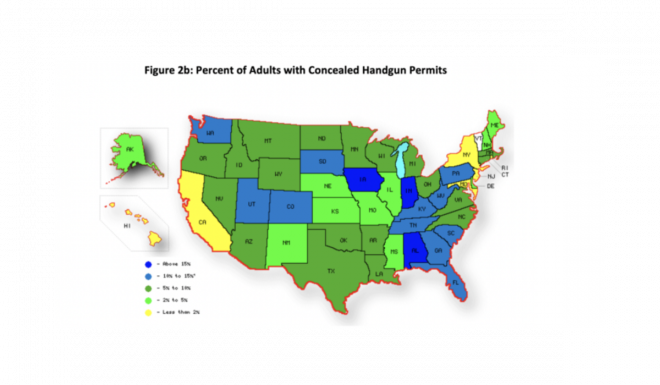CRPC Releases Annual National Concealed Carry Report for 2020
Eve Flanigan 10.05.20

John Lott and Rujun Wang, of Crime Prevention Research Center (CRPC), just unveiled the center’s latest annual report on concealed carry. Even though there are three months left in 2020, the report reveals numerous interesting trends.
Caveats in data quality are mostly due to an increase in the number of states (now 17) that do not require a permit or license to carry concealed. Most of these are not keeping data, but some do.
Here are a few highlights from the published summary. For a detailed look at this and previous years’ reports since 2014, check out this link to Crime Prevention Research Center.
- Concealed carry licensure continues to grow, but not as fast.
The number of permit holders increased by 820,000. That represents just 4.4% over 2019, the most sluggish grown since 2011. CRPC states the reason for slower growth is two-fold: growth in states moving to permitless carry policies, and state governments’ corona virus-related shutdowns. Thanks to the increase in permitless carry states, it’s likely that the actual number of people carrying concealed has increased more than this number shows.
- Lots of Americans are licensed to carry.
Nationally speaking, 7.6% of adults have a permit. Omit severely restrictive, highly populated California and New York, and about 9.2% of adults are licensed.
- Really, a LOT of Americans.
More than 10% of adults are licensed in 14 states, including Alabama (the highest at 28.45%), Indiana, Iowa, Pennsylvania, South Dakota, Georgia, Tennessee, South Carolina, Colorado, Utah, Kentucky, Florida, Washington, and West Virginia. Two states, Alaska and Arkansas, fell off the list, probably because they implemented permitless carry.
- More women are licensed.
Only 14 states keep data on the gender of concealed carry licensees. Of these, 26.4% of all people licensed are women. The number of permits issued to women grew 101% faster than for men.
- Licensure of racial minorities is increasing remarkably, if the three-state sample is any indication.
Only Texas, North Carolina, and Oklahoma collect applicants’ racial data. In Texas, from 2002 to 2019, the rate of black female applicants has increased 3.9 times as compared to white males. In that same 17-year period, Oklahoma’s approvals for Asians and American Indians were more than twice that for whites. Looking all the way back to 1996, permits for blacks in North Carolina have increased twice as fast as for whites.
- Carry by Asian people is increasing exponentially.
Since 2015, in the four states that collect race data, Asians represent the largest increase in permitted concealed carry. Their licensure has grown 62.9% faster than for white people.
These stats represent a very small slice of the information available in the report. Scientists are always careful to remind us that “correlation doesn’t equal causation.” The report gives multiple indicators of violent crime compared to licensure. Whether it’s due to the presence of concealed handguns or not, rates of murder and other violent crimes decreased by a significant amount in the top 20 states for concealed carry. Other studies by John Lott engaged multivariate analyses to show that, yes, more guns really do equal less crime. He’s careful to point out that it’s penalties for crime that are the primary crime deterrent, however the presence of guns is a strong partner with those policies.